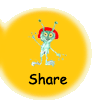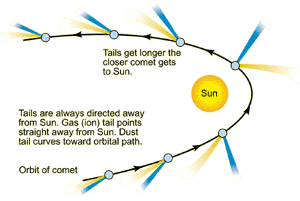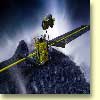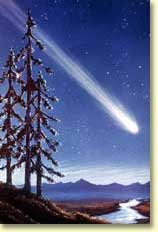

Long ago, the sight of a comet frightened people. With its bright head and long, wispy tails, comets did not look like anything else in the sky. And, unlike the sun, stars, and moon, comets did not seem to appear on any schedule. Comets were a deep mystery. |
|
Comets are the icy leftovers from when our solar system formed. We can learn much about how the solar system began by studying comets. We have taken wonderful pictures of comets, but we have never before landed on one. Now a mission is being planned to do just that and bring comet samples home to Earth!
Which comet will the Comet Nucleus Sample Return mission visit? We don't yet know. We do know that when the spacecraft arrives, it will have a very exciting time carrying out its assignments.
After landing, the spacecraft will gather samples of the comet material. It will drill below the surface for some of the samples. Since comets have very little gravity, the spacecraft will have to anchor itself to the surface before it can drill for samples.
What surprising things will we learn about these beautiful and strange objects?
Did you try your hand at the Comet Wordfind game?
|
 |
 |
 |
 |
 |
 |
|
| |||||
 We now know that comets are part of our solar system. Like the planets, they orbit the sun. Some comets, called short-period comets, take up to 200 years to make one orbit. But some comets have orbits so big and elliptical (shaped like a squashed circle) it may take millions of years to make one trip around the sun!
We now know that comets are part of our solar system. Like the planets, they orbit the sun. Some comets, called short-period comets, take up to 200 years to make one orbit. But some comets have orbits so big and elliptical (shaped like a squashed circle) it may take millions of years to make one trip around the sun!  First, it will land on the comet's nucleus (the solid part). We don't even know what the surface will be like! It may be soft, like cotton candy, or hard like a rock. Gases and chunks of stuff may be boiling off the surface. After all, it is gases, dust, and ice particles from the nucleus that make up the comet's long tails.
First, it will land on the comet's nucleus (the solid part). We don't even know what the surface will be like! It may be soft, like cotton candy, or hard like a rock. Gases and chunks of stuff may be boiling off the surface. After all, it is gases, dust, and ice particles from the nucleus that make up the comet's long tails.  Then, part of the spacecraft will blast off from the comet and bring the samples back to Earth for study.
Then, part of the spacecraft will blast off from the comet and bring the samples back to Earth for study.